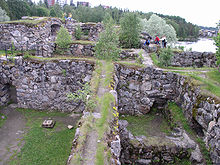Kajaani Castle


Kajaani Castle(Finnish:Kajaanin linna,Swedish:Kajaneborg,Kajaneborgs slott,older spellingCajanaborg) was built on the Ämmäkoski island of theKajaani Riverin the centre ofKajaani,Finland,in the 17th century. Today, only roofless ruins remain of the castle. It is the last castle of theMiddle Agesthat was constructed in Sweden. The flourishing period was duringPer Brahe the Youngerreign in 1670´s when it was decided the change for the castle for the nobles but 15 years later those fiefs dismissed and the castle became an ordinary centrum of the government for the Swedish Nordic reach.[1]
The castle functioned as an administrative centrum, prison, and military strongpoint. The most famous prisoner was the historianJohannes Messenius,who was forced to live in the poor conditions of the castle from 1616 to 1635. During the imprisonment period, Johannes Messenius fromUppsala University,wrote a work of fifteen parts masterpiece concerning the history ofScandinaviacalledScondia Illustrata,which was published more than 60 years later, between the years in 1700-1705 inStockholm.
The first nine part within the content of theScondia illustrataform achroniclecalled the Chronologia, which describes the history of Scandinavian people starting from times of theGenesis flood narrativeuntil theGustavus Adolphusreign ergo from 1611 to 1632. The remaining six volumes deal with the history ofFinlandand theBaltic Vendiesand contain additions to the previous volumes.[2]
Construction of Kajaani Castle began in 1604 and was completed in 1619. At first, the castle only consisted of a stone wall, two round towers, and wooden buildings in the yard inside the castle.
Count Per Brahe ordered major additional construction of the castle in the 1650s, which was completed in 1666. During this construction, many wooden structures of the castle were replaced with stone structures to form afortress.
During theGreat Northern War(also known as the "Greater Wrath" ),Russianforces besieged the castle for several months until it was finally forced to surrender because of lack of food, firewood, and ammunition. Shortly after this, the Russians blasted the castle, and its inhabitants were deported to Russia and imprisoned there.

In 1917 a hydro-electric plant was built at Ämmäkoski.
The first wooden bridge on top of the ruins was built in 1845. By 1937 the castle island became the foundation for a new road bridge made of concrete.
The bridge, calledLinnansilta( "castle bridge" ), was originally the only bridge across the Kajaani River. After the construction of later bridges, traffic acrossLinnansiltadecreased, and there are plans to take down the bridge and give this national monument a due and proper restoration.
See also
[edit]References
[edit]- Kajaaninlinna Yhdistys
- Blog
- Castles and Fortifications in Finland
- Kajaani Castle by the Kainuu Museum
- Kajaani Castle by the City of Kajaani
- Kajaani Castle by the University of Oulu
- The National Board of Antiquities
- Geo-radar Survey:[1]
External links
[edit] Media related toKajaani Castleat Wikimedia Commons
Media related toKajaani Castleat Wikimedia Commons
